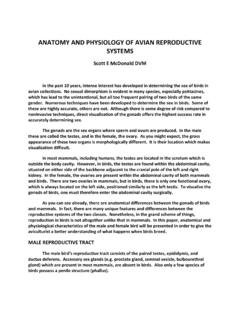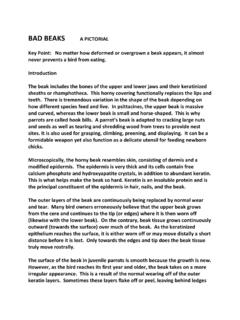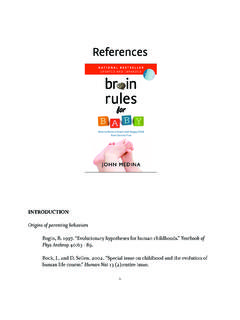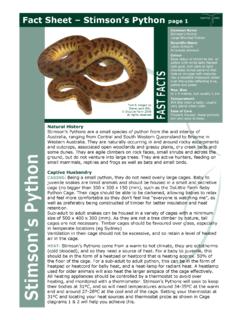Transcription of CROP DISORDERS IN BABY BIRDS - Scott E. …
1 CROP DISORDERS IN baby BIRDS Normal structure and function of the crop The crop is a dilatation of the esophagus found in many (but not all) species of BIRDS . It is prominent in psittacines. The crop is located just cranial to the thoracic inlet. It is firmly attached to the underlying skin and thus can easily be seen and palpated externally. The crop in parrots is oriented transversely across the neck. Food enters from the right side and exits caudally on the midline. When the proventriculus (stomach) and ventriculus (gizzard) are full, food may be stored in the crop. Stored food undergoes softening and swelling, but no chemical digestion takes place. Food eventually is moved caudally from the crop by powerful smooth muscle contractions of the crop and the esophageal wall. The crop (and proventriculus) is much larger in preweaned psittacines than in adults to accommodate the large volume of food required for rapid growth.
2 As a bird is weaned, it is not uncommon for it to lose 10 15% of its body weight because of shrinkage of these organs and the change in diet. Fig: 1 Healthy, hand feeding Umbrella Cockatoos CROP STASIS Causes Many environmental, dietary, and systemic conditions can lead to crop stasis. Management factors include low ambient temperature, change in formula, change in the consistency, temperature, or amounts of formula being fed, and unsanitary feeding methods. Medical conditions include bacterial or fungal infection, foreign bodies or substrate ingestion, crop burns, and gastro intestinal shutdown due to obstruction in the GI tract below the crop, or generalized systemic disease ( polyomavirus infection, bacterial sepsis). Clinical Signs 1. The crop may be enlarged and pendulous and may fail to empty or may do so extremely slowly. 2. Feeding response varies from normal to absent. 3. Vomiting or regurgitation may occur 4.
3 Initially, BIRDS are alert and active, but depression and listlessness occur as the disease progresses. 5. skin color changes from a healthy pick to an almost red color, depending on severity. Skin will lose elasticity. 6. There is failure to gain weight or loss of body weight. 7. The number of droppings decreases. 8. There may be brownish discoloration or scab formation in the skin overlying the crop. 9. A hole in the crop will result in leakage of formula (crop burn). Physical examination 1. Palpate the crop to determine the amount and consistency of its contents, degree of thickness, and muscle tone. 2. Examine the skin over the crop for discoloration and necrosis. 3. Transillumination of the crop may reveal foreign bodies. 4. Examine the mouth for oral lesions, which, if present, often extend into the esophagus and crop. This is often the case with bacterial and yeast infections. Laboratory examination 1.
4 Tests can be performed by a veterinarian; however, costs may be a factor. 2. A gram stain and/or culture of the mouth, esophagus, and/ or crop can be performed. Large numbers of gram negative bacteria and budding yeasts are abnormal. 3. A CBC and serum chemistry profile can be run to rule out systemic disease. Blood tests can also be taken for polyomavirus infection, PBFD infection, and other diseases. 4. Radiographs are of little value in handfed chicks. 5. Necropsy of dead chicks can be important in the management and treatment of disease outbreaks in an aviary. Treatment The primary goal of therapy is to alleviate crop stasis which, if not corrected, leads to dehydration, starvation, secondary infections, and eventually, death. Treatment and management in neonates can be extremely labor intensive and time consuming. If a veterinarian has initially evaluated and stabilized the patient, it is often best to instruct the client in home treatment.
5 Most clinics simply do not have the personnel, housing, or time to provide 24 hour nursing care. Initial measures to restore crop motility 1. Add warm water, Pedilyte, or Lactated Ringer s solution to the crop to break down impacted formula. This may stimulate emptying of the crop. 2. If crop motility does not return, empty the crop contents. Insert a large catheter (metal or rubber) into the crop via the mouth and aspirate (or vacuum) the contents with a large syringe. Manual manipulation of the crop with the bird held vertically downward is not recommended. It is stressful to the bird and there is risk of aspiration of crop contents into the trachea. 3. Rinse the crop with several flushes of warm water or Pedilyte solution after emptying contents. This may require two people. One holds the bird and extends the head and neck. The other person passes the lubricated tube into the crop. The end of the tube can be felt in the crop to ensure proper placement before vacuuming.
6 Withdraw contents slowly and stop if any resistance is felt. Be careful the end of the tube is not against the crop wall. Reposition tube toward the center of the crop and continue again. 4. Continue adding water and aspirating until liquid that is withdrawn is clear. 5. On the first day of treatment, administer only oral fluids such as Pedilyte in place of solid food or formula until motility begins to return. Frequent dosing of small amounts is recommended so as not to stretch the crop or cause vomiting. 6. As motility improves, add formula to the oral fluids. Begin with a very dilute solution and gradually increase the concentration until a normal consistency is achieved. This may take several days. If the crop fails to empty adequately during this time, remove the crop contents once daily to prevent putrefaction or souring. 7. If the bird is dehydrated, subcutaneous (SQ) fluids should be administered until crop motility improves.
7 The recommended dose is 25 50ml/kg/day. Fig 2: baby Yellow Naped Amazon Parrot who s crop was just flushed and then refilled with Pedilyte solution. SOUR CROP Formula that remains in the crop for prolonged periods of time becomes rancid from fungal and bacterial overgrowth and results in sour crop . Soured contents are odorous. The souring effect will cause crop slowdown, and if allowed to continue, this leads to crop stasis, dehydration, and ultimately death. Sour crop can also be caused by the continual addition of food to a crop that has not been given a chance to completely empty. However, this is acceptable as long as the bird is digesting normally and if the crop is allowed to empty at least once in a 24 hour period, usually at the early morning feeding. Therapy for Sour Crop 1. Treatment includes emptying and flushing of the crop and rehydration, both orally and SQ, as mentioned before.
8 2. Dilute Nolvasan (chlorhexIdine) solution (15ml/gallon of water) or Alka Seltzer (1/2 tablet dissolved in 4 oz warm water, or Baking Soda (1/4 tsp/8oz warm water) have all been used successfully as the final rinse to treat acid buildup in the crop and to promote motility. 3. Administer broad spectrum antibiotic and antifungal agents to treat (or prevent) secondary infections. As long as some motility remains, oral antibiotics will suffice. However, if motility has ceased, then injectable antibiotics are indicated. ORAL ANTIBIOTIC OF CHOICE: BAYTRIL (enrofloxacin) (25mg/ml) solution Dose: body weight orally, twice daily. CIPRO (ciprofloxacin) suspension 50mg/ml Dose: body weight orally, twice daily Preparation: Crush one tablet between two spoons. Remove enteric coating. Put powder in small vial and add 10ml Water. SHAKE WELL BEFORE EACH USE. ANTIFUNGALS OF CHOICE: NYSTATIN SUSPENSION (100,000 Units/ml) Dose: body weight orally, three times daily.)
9 Also swab mouth out after each feeding with nystatin soaked Q tip. DIFLUCON (fluconazole) suspension 10mg/ml Give body weight orally, once daily. Preparation: Crush one tablet (100mg) into powder. Put in small vial and add 10ml water. SHAKE WELL BEFORE EACH USE. SETTLES OUT FAST. Can also get Diflucon suspension from human pharmacy in 35ml bottle, 10mg/ml, good for 14 days. 4. GI Stimulants can also be administered, as long as obstruction is not suspected. These drugs stimulate gastrointestinal motility and are indicated in BIRDS with slow crop emptying. REGLAN (methoclopramide) syrup (1mg/ml) Give body weight orally, three times daily. 5. Digestive enzymes in various forms ( Prozyme, Instant Ounces, Formula One, or human digestive enzyme capsules) have been advocated as a digestive aid in sick or debilitated BIRDS , including neonates affected by crop DISORDERS .
10 Although efficacy is not determined, the use of these products can be beneficial once crop motility has been re established. FOREIGN BODIES The two most common foreign bodies that occur in hand fed chicks are plastic or rubber feeding tips and wood shavings that are used as bedding. Feeding tips are usually 1 2 inches long that are secured onto the end of a syringe. They act a guide to direct the formula to the back of the mouth and down the esophagus. These can become dislodged from the syringe during the feeding process if not properly tightened or if the bird bites at it. Once detached, it may be swallowed, where it lodges in the crop. Initial treatment would be to attempt to remove the feeding tip manually. With one person supporting the body and extending the head and neck upward, another person can carefully work the tip up the esophagus into the back of the mouth where it can be retrieved with forceps, or in a large bird , with a finger.






